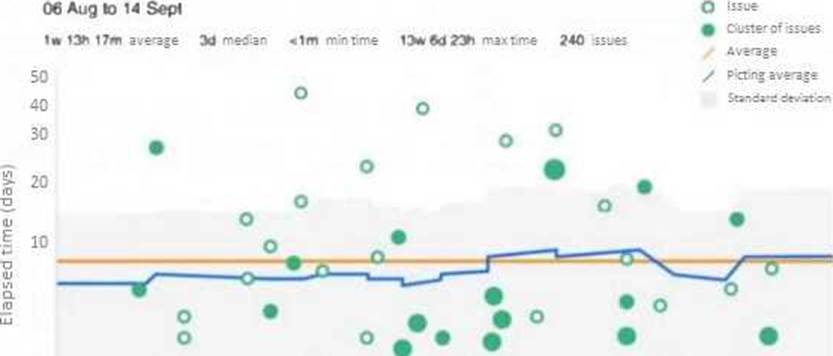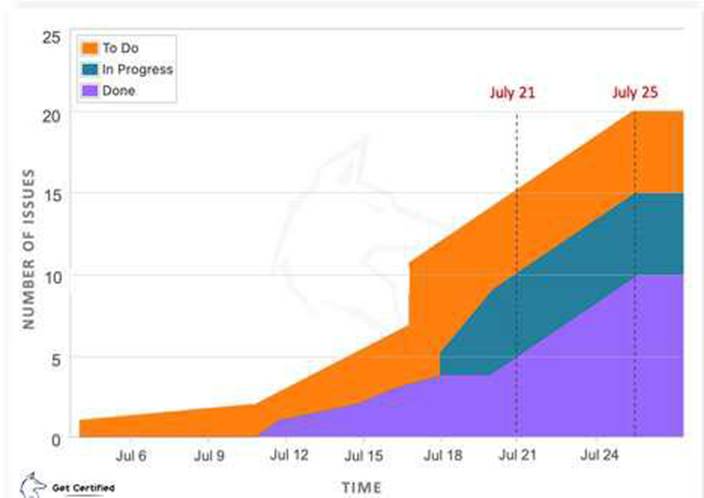Practice Free ACP-620 Exam Online Questions
Currently, you are the only person maintaining quick filters for the team.
You want Ravi to help you. You also want Ravi to grant that same ability to others, if needed.
What should you do?
- A . Create a custom role.
- B . Make Ravi the project administrator.
- C . Make Ravi the project lead.
- D . Make Ravi a board administrator.
- E . Add Ravi to the Administrators project role.
D
Explanation:
To allow Ravi to maintain quick filters and grant that ability to others, you need to make him a board administrator. Board administrators can manage board settings, including quick filters, and can also assign board admin rights to others.
Your team uses a company-managed Kanban project and needs a way to categorize issues as follows:
● group issues by the project phase in which work will be started
● assign a fixed start date and end date to each phase
● move unresolved issues to the next phase
● view reports of resolved issues by phase
Which product feature should be used to categorize the issues?
- A . categories
- B . sprints
- C . components
- D . versions
- E . labels
D
Explanation:
Versions in a company-managed project are designed to represent project phases with fixed start and end dates, allow tracking of resolved and unresolved issues, and automatically move unresolved issues to the next version. They also support reporting by version, making them the best fit for this use case.
You shared a URL to the dashboard with Bobby but when he looks at it, the gadgets return errors that state, "The filter configured for this gadget could not be retrieved."
What is the most likely problem with the filters?
- A . They return issues from team-managed projects.
- B . They return issues with hidden fields.
- C . They are not shared with Bobby.
- D . They contain corrupt JQL clauses.
C
Explanation:
The error "The filter configured for this gadget could not be retrieved" typically means that the filters used in the dashboard gadgets are not shared with Bobby. Even if Bobby has access to the projects or issues, he cannot see the results unless the filters themselves are explicitly shared with him.
You are the project administrator for a team based in the Middle East.
You need to change the Standard Working Days configuration on the board: from Sunday to Thursday instead of Monday to Friday.
What will be affected by this change?
- A . Velocity Chart
- B . sprint duration
- C . Average Age Report
- D . original estimates on issues
- E . Burndown Chart
E
Explanation:
Changing the Standard Working Days affects the Burndown Chart, as this chart relies on working days to plot the ideal and actual burn of work during a sprint. Adjusting working days ensures the burndown chart accurately reflects the team’s actual schedule.
The TIS project automation rule is configured as shown.

Charlie changed the priority of issue TIS-25 from High to Highest.
But the issue does not get assigned to Kimmy automatically.
Identify the root cause.
- A . Charlie does not have the Assign issues permission.
- B . Kimmy does not have the Assign issues permission.
- C . The project’s Default Assignee is Unassigned.
- D . The automation rule is not triggered by this action.
D
Explanation:
The rule is configured to trigger only when an issue is created with the highest priority. Changing the priority after creation does not trigger the rule, which is why issue TIS-25 was not assigned to Kimmy.
Which of the following are the available scopes in Jira automation? (Choose four.)
- A . Multiple projects
- B . Project type
- C . Single project
- D . Issue type
- E . All projects
- F . Multiple issue types
A C D E
Explanation:
In Jira Automation, you can define the scope of your automation rule to be any of the following:
Single project: The automation rule will only apply to the project you’re currently working in.
Multiple projects: You can select multiple projects that the automation rule will apply to.
All projects: The automation rule will apply to all projects in your Jira instance.
Issue type: You can also define the scope of your automation rule based on specific issue types.
There is no specific option for "Project type" or "Multiple issue types" as an automation scope, although you can define rules that consider these aspects within a given project or across multiple/all projects.
A user wants to add the label VIP to an issue when any member of the Executives group adds a comment to it.
The configuration of the automation rule is shown.

The automation rule does not always execute as expected.
What is the cause of the problem?
- A . The label VIP is not available in the issue’s project.
- B . User condition has to be the trigger.
- C . A condition is missing to check whether the label is already set.
- D . User condition does not account for who is commenting.
- E . Issue commented has to be the condition.
D
Explanation:
The user condition is checking whether the reporter is in the Executives group, but the rule is triggered when the issue is commented on. To work as intended, the condition should check whether the commenter (i.e., user who triggered the rule) is in the Executives group – not the reporter.
The Control Chart for the Orange team board is shown.

What two items can you interpret from this report? (Choose two.)
- A . Issues in the report use time-based estimation.
- B . The fastest time any issue transitioned to done was less than one minute.
- C . The team slowly became faster at transitioning issues to done.
- D . Issues on average take over one week to transition to done.
- E . The team’s cycle time is slowly becoming more predictable.
B, D
Explanation:
The minimum time shown is <1 minute, which indicates the fastest an issue transitioned to done.
The average time shown is 1w 13h 17m, which confirms that on average, issues take over one week to complete.
Based on the below diagram, which statements are true? (Choose three.)

- A . On July 25th, the ‘To Do’ status has the highest number of issues compared with other statuses.
- B . In Progress’ status on July 21st and July 25th have the same number of issues.
- C . On July 25th, the ‘Done’ status has the highest number of issues compared with other statuses.
- D . In Progress’ status on July 21st and July 25th have different number of issues.
- E . On July 25th, all statuses have the same number of issues.
- F . On July 21st, all statuses have the same number of issues.
B, C, F
Explanation:
On July 21st, there are:
– 5 issues in ‘To Do’
– 5 issues in ‘In Progress’
– 5 issues in ‘Done’
– 10 issues in ‘Done’
Reference: View and understand the cumulative flow diagram
Jira automation helps users to automate repetitive manual works and focus more on the team’s productivity.
Which of the following are true about Jira automation? (Choose three.)
- A . Users can refer to the Audit Log to check automation logs.
- B . The automation owner will always receive an email if the automation is failing.
- C . Users can create an automation to trigger other automations.
- D . Only the rule owner will receive an email notification if automation is failing.
- E . By default, the actor of the automation is the creator of the automation.
- F . Users can apply one automation to a single project only.
A, D, E
Explanation:
Jira automation is a powerful tool in Jira that allows users to automate manual, repetitive tasks. Any changes or execution of automation rules are logged in the Audit Log for transparency and troubleshooting purposes. If an automation rule fails, an email is sent to the owner of that rule. By default, the actor (i.e., the user who appears to perform the automated action) is the creator of the automation rule. However, it’s also possible to specify a different user as the actor in the automation rule configuration. Users can create automations that span multiple projects, not limited to a single project. As of my knowledge cutoff in September 2021, triggering other automations from an automation is not directly supported.
